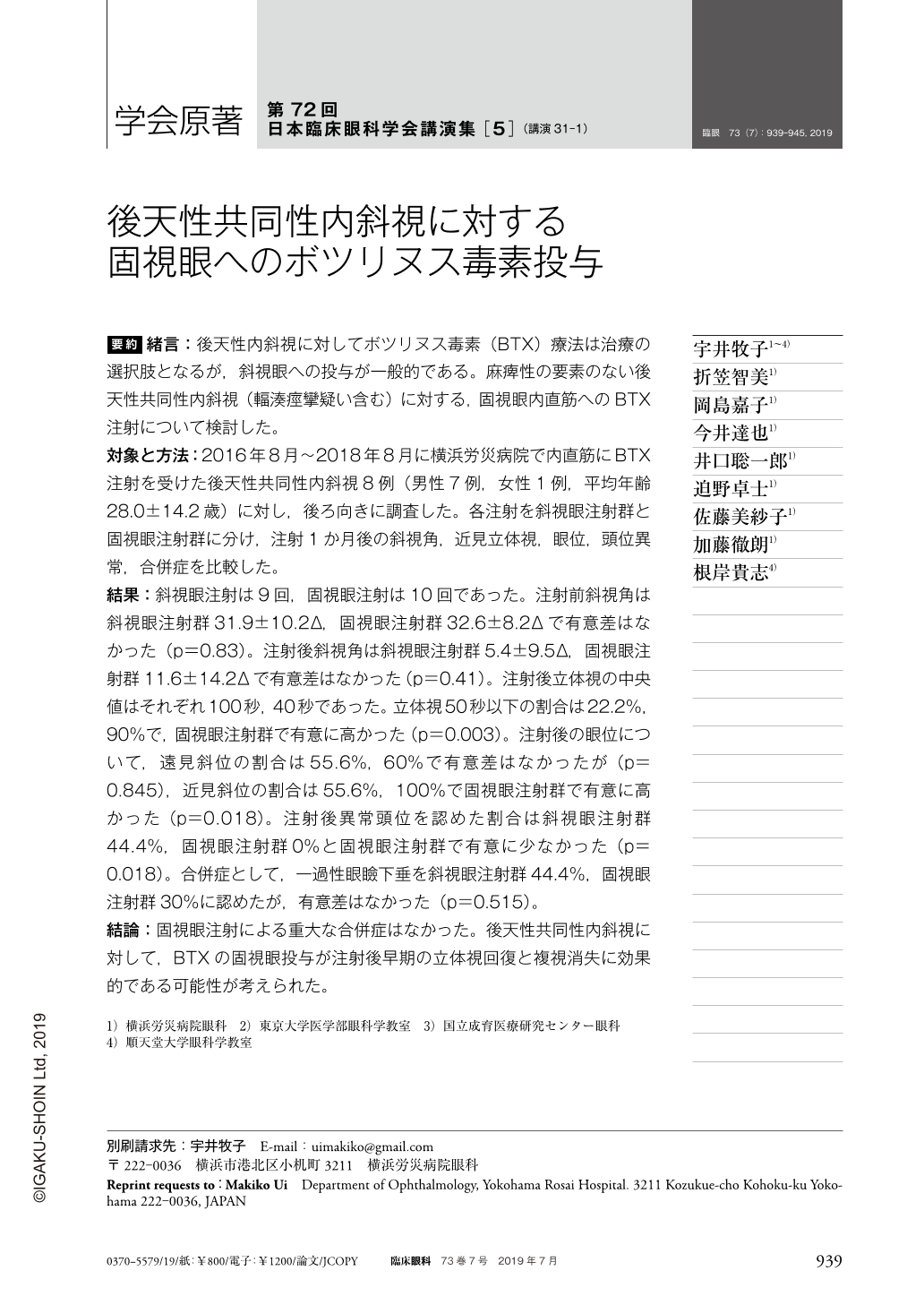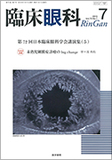Japanese
English
- 有料閲覧
- Abstract 文献概要
- 1ページ目 Look Inside
- 参考文献 Reference
要約 緒言:後天性内斜視に対してボツリヌス毒素(BTX)療法は治療の選択肢となるが,斜視眼への投与が一般的である。麻痺性の要素のない後天性共同性内斜視(輻湊痙攣疑い含む)に対する,固視眼内直筋へのBTX注射について検討した。
対象と方法:2016年8月〜2018年8月に横浜労災病院で内直筋にBTX注射を受けた後天性共同性内斜視8例(男性7例,女性1例,平均年齢28.0±14.2歳)に対し,後ろ向きに調査した。各注射を斜視眼注射群と固視眼注射群に分け,注射1か月後の斜視角,近見立体視,眼位,頭位異常,合併症を比較した。
結果:斜視眼注射は9回,固視眼注射は10回であった。注射前斜視角は斜視眼注射群31.9±10.2Δ,固視眼注射群32.6±8.2Δで有意差はなかった(p=0.83)。注射後斜視角は斜視眼注射群5.4±9.5Δ,固視眼注射群11.6±14.2Δで有意差はなかった(p=0.41)。注射後立体視の中央値はそれぞれ100秒,40秒であった。立体視50秒以下の割合は22.2%,90%で,固視眼注射群で有意に高かった(p=0.003)。注射後の眼位について,遠見斜位の割合は55.6%,60%で有意差はなかったが(p=0.845),近見斜位の割合は55.6%,100%で固視眼注射群で有意に高かった(p=0.018)。注射後異常頭位を認めた割合は斜視眼注射群44.4%,固視眼注射群0%と固視眼注射群で有意に少なかった(p=0.018)。合併症として,一過性眼瞼下垂を斜視眼注射群44.4%,固視眼注射群30%に認めたが,有意差はなかった(p=0.515)。
結論:固視眼注射による重大な合併症はなかった。後天性共同性内斜視に対して,BTXの固視眼投与が注射後早期の立体視回復と複視消失に効果的である可能性が考えられた。
Abstract Background:To evaluate Botulinum injection into the fixating eye for acquired comitant esotropia(including convergence spasm suspect)which is excluded paralytic strabismus.
Subjects and Methods:The medical records of eight patients with acquired comitant esotropia(seven males and one female, average age of 28.0±14.2)who received Botulinum injection into medial rectus muscle at Yokohama Rosai Hospital from August 2016 to August 2018 were reviewed. Injections were divided into the strabismus eye injections group and the fixating eye injections group. Angle of deviation, stereoacuity, ocular alignment, percentage of abnormal head posture and complications at one month of injections were analyzed.
Results:There were 9 injections in the strabismus eye injections group and 10 injections in the fixating eye injections group. Angle of deviation before injections was not significantly different(31.9±10.2Δ vs 32.6±8.2Δ, p=0.83). Angle of deviation after injections was not significantly different(5.4±9.5Δ vs 11.6±14.2Δ, p=0.41). Median stereoacuity was 100 arcsec and 40 arcsec respectively, and the rate of stereoacuity no more than 50 arcsec was significantly high in fixating eye injections group(22.2% vs 90%, p=0.003). The rate of phoria at far distance was not significantly different(55.6% vs 60%, p=0.845), while the rate of phoria at near distance was significantly high in the fixating eye injections group(55.6% vs 100%, p=0.018). Percentage of abnormal head posture was significantly low in fixating eye injections group(44.4% vs 0%, p=0.018). Percentage of transient ptosis as complication of injections was not significantly different(44.4% vs 30%, p=0.515).
Conclusions:There were no serious complications by Botulinum injections into the fixating eye. Early recovery of binocular function and disappearance of diplopia is expected by Botulinum injections into the fixating eye.

Copyright © 2019, Igaku-Shoin Ltd. All rights reserved.


